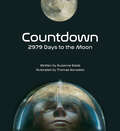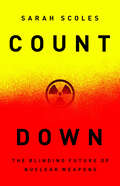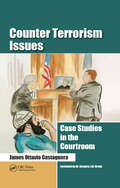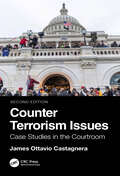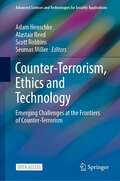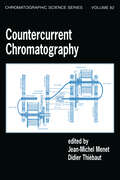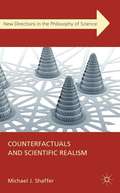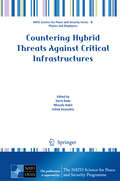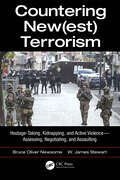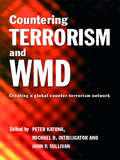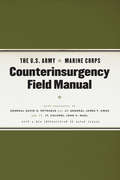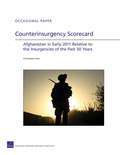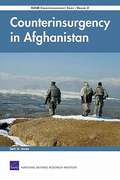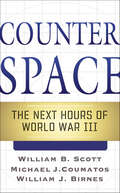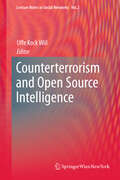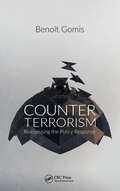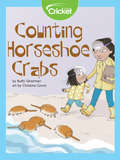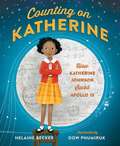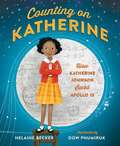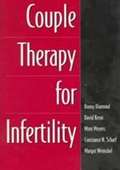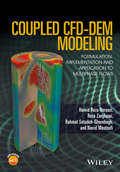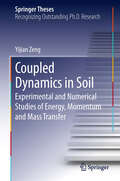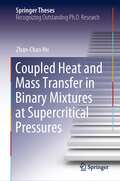- Table View
- List View
Countdown: 2979 Days to the Moon
by Suzanne SladeThe captivating true story of NASA's effort to land the first man on the Moon is told through powerful free verse and stunning illustrations. An inspiring testament to American grit, teamwork, and ingenuity, Countdown presents exhilarating, informative, and accessible free verse by award-winning author Suzanne Slade paired with historic photographs and detailed illustrations by New York Times best-selling illustrator Thomas Gonzalez. Together, they capture the gripping historic story of NASA's twentieth century efforts to conquer a new space frontier. Through triumph and tragedy, success and failure, an entire nation is glued to the high-stakes, 2,979-day mission as eighteen astronauts climb into spacecraft; three men die before even leaving the ground; eight rockets soar into space; and four hundred thousand people―engineers, technicians, scientists, mathematicians, and machinists―join Project Apollo in pursuit of making a dream a reality.
Countdown: The Blinding Future of Nuclear Weapons
by Sarah ScolesFor fans of Oppenheimer, a riveting investigation into the modern nuclear weapons landscape. Nuclear weapons are, today, as important as they were during the Cold War, and some experts say we could be as close to a nuclear catastrophe now as we were at the height of that conflict. Despite that, conversations about these bombs generally often happen in past tense. In Countdown, science journalist Sarah Scoles uncovers a different atomic reality: the nuclear age&’s present. Drawing from years of on-the-ground reporting at the nation's nuclear weapons labs, Scoles interrogates the idea that having nuclear weapons keeps us safe, deterring attacks and preventing radioactive warfare. She deftly assesses the existing nuclear apparatus in the United States, taking readers beyond the news headlines and policy-speak to reveal the state of nuclear-weapons technology, as well as how people currently working within the U.S. nuclear weapons complex have come to think about these bombs and the idea that someone, someday, might use them. Through a sharp, surprising, and undoubtedly urgent narrative, Scoles brings us out of the Cold War and into the twenty-first century, opening readers' eyes to the true nature of nuclear weapons and their caretakers while also giving us the context necessary to understand the consequences of their existence, for worse and for better, for now and for the future.
Counter Electrodes for Dye-sensitized and Perovskite Solar Cells
by Anders Hagfeldt Sining YunA guide to one of the most important aspects for affordable and highly efficient dye-sensitized solar cells Dye-sensitized solar cells have the potential to be one of the most promising photovoltaic technologies for production of renewable and clean energy. Counter Electrodes for Dye-Sensitized and Perovskite Solar Cells offers an introduction to the various types of counter electrode catalysts for dye-sensitized solar cells and perovskite solar cells, including metal and metal compounds, carbon materials, polymers, and composites. With contributions from an international panel of experts, the book contains a discussion of the design and synthesis of the catalysts, characterization and stability of the devices, as well as calculations on properties. The contributors cover a wide range of topics including information on: carbon nanotubes electrocatalysts for I-mediated dye-sensitized solar cells; Pt-loaded composite electrocatalysts for I-mediated dye-sensitized solar cells; metal contact electrodes for perovskite solar cells; and much more. The book also includes insight into the future developments in the field. This important resource Covers the various types of counter electrode catalysts and presents design strategies, synthesis methods, theoretical calculation and stability evaluation Includes information on low-cost counter electrode catalysts and commercial applications of dye-sensitized sensitized solar cells Disscuses how electrode catalysts can be applied in a range of fields, such as solar cells, fuel cells, hydrogen production, and photocatalysis Offers contributions from leading experts in the field including Anders Hagfeldt, one of the world's leading researchers in this field Written for materials scientists, solid state chemists, electrochemists, catalytic chemists, solid state physicists, and chemical industry professionals, Counter Electrodes for Dye-Sensitized and Perovskite Solar Cells is a comprehensive and authoritative guide to dye-sensitized solar cells.
Counter Terrorism Issues: Case Studies in the Courtroom
by James Ottavio CastagneraThe American legal profession and judicial system bear a unique responsibility to set and maintain the balance between defending homeland security and protecting the civil liberties outlined in the Bill of Rights. These competing interests will continue to collide as the threats to our safety grow. Exploring the most significant terrorist cases of
Counter Terrorism Issues: Case Studies in the Courtroom
by James Ottavio CastagneraCounter Terrorism Issues: Case Studies in the Courtroom, Second Edition presents a panoramic view of the American judiciary’s handling of domestic terrorism in the last 30 years. As has played out in recent history, the American legal profession and judicial system bear a unique responsibility to set and maintain the balance between defending homeland security and protecting the civil liberties outlined in the Bill of Rights. These competing interests will continue to collide as the threats to our safety grow.The book examines some of the most notorious cases—the two attacks on the World Trade Center, the Oklahoma City bombing, and the Fort Hood massacre. Updates from the First Edition include a reflection on the Boston Marathon bombing, as well as an examination of the events of January 6, 2021, the subsequent legal proceedings and convictions of those involved in the assault on the U.S. Capitol, and the danger arising from increased domestic extremism and violent rhetoric from the right.Drawing extensively upon trial transcripts, witness statements, and judicial opinions, the book reviews the events and cases to demonstrate how the criminal justice system has grappled with conflicting facts and countervailing legal rights and responsibilities. Through the words of witnesses, judges, and the attorneys who tried these cases in America’s courtrooms, coverage provides important commentary on the historical/political contexts of these events, enabling readers to understand the significance of these infamous attacks on U.S. soil.
Counter-Terrorism, Ethics and Technology: Emerging Challenges at the Frontiers of Counter-Terrorism (Advanced Sciences and Technologies for Security Applications)
by Seumas Miller Adam Henschke Alastair Reed Scott RobbinsThis open access book brings together a range of contributions that seek to explore the ethical issues arising from the overlap between counter-terrorism, ethics, and technologies. Terrorism and our responses pose some of the most significant ethical challenges to states and people. At the same time, we are becoming increasingly aware of the ethical implications of new and emerging technologies. Whether it is the use of remote weapons like drones as part of counter-terrorism strategies, the application of surveillance technologies to monitor and respond to terrorist activities, or counterintelligence agencies use of machine learning to detect suspicious behavior and hacking computers to gain access to encrypted data, technologies play a significant role in modern counter-terrorism. However, each of these technologies carries with them a range of ethical issues and challenges. How we use these technologies and the policies that govern them have broader impact beyond just the identification and response to terrorist activities. As we are seeing with China, the need to respond to domestic terrorism is one of the justifications for their rollout of the “social credit system.” Counter-terrorism technologies can easily succumb to mission creep, where a technology’s exceptional application becomes normalized and rolled out to society more generally. This collection is not just timely but an important contribution to understand the ethics of counter-terrorism and technology and has far wider implications for societies and nations around the world.
Countercurrent Chromatography (Chromatographic Science Series)
by Jean-Michel Menet Didier ThiebautCovering definitions, concepts, and applications, Countercurrent Chromatography recounts the developments in two types of liquid-liquid chromatography termed countercurrent-high-speed countercurrent chromatography (HSCCC) and centrifugal partition chromatography (CPC)-as well as the HSCCC-derived cross-axis CCC, a versatile technique for purificati
Counterfactuals and Scientific Realism
by Michael J. ShafferScientific realism is the view that the sciences aim to discover scientific theories that are true, or at least approximately true. Scientific realism is widely accepted by both scientists and philosophers of science. However, in practice - and perhaps even in principle - scientists are forced to simplify theories by idealizing. Some more skeptical philosophers of science have questioned the acceptability of scientific realism because they claim that theories involving idealizations are not even approximately true. This book is an attempt to show that scientific realism is compatible with the presence of idealization in the sciences. The main contention of this book is that idealized theories can be treated as counterfactuals about how things are in worlds that are similar to but simpler than the actual world. So understood it is clear that they have perfectly ordinary truth conditions. This implies that scientific theories that incorporate idealizations can be true despite the objections of anti-realists.
Countering Hybrid Threats Against Critical Infrastructures (NATO Science for Peace and Security Series B: Physics and Biophysics)
by Ashok Vaseashta Dorin Radu Mirsada HukićThis proceedings volume presents a collection of articles from key practitioners from relevant areas with experience in critical infrastructure. The authors acknowledge that the responsibility for critical infrastructure protection is primarily a matter of international importance, hence a high degree of cross-border and cross-sectoral interdependencies must be coordinated or, where appropriate, legally harmonized efforts at the international level, including the smooth functioning of the internal policies. The book focuses on countering hybrid threats that render critical infrastructures vulnerable. An understanding of such threats will render critical infrastructure safe, secure, and resilient. The protection of national critical infrastructures, as well as of the functions and services critical to the proper functioning of society is a key priority and requires a new unique and strategic approach. Work in this direction must consider the strong interdependencies between the various critical functions and services, including financial services, the key role of the private sector, the changing security environment, and emerging risks, both in the physical and cyber fields. In addition to legal requirements, agreements should be promoted with private sector infrastructure and service owners and operators to ensure the continuity of and access to critical services, including beyond force majeure, by ensuring an acceptable level of preparedness to respond. all relevant threats, as well as the flexibility to address and mitigate the effects of low-probability, high-impact events.
Countering New(est) Terrorism: Hostage-Taking, Kidnapping, and Active Violence — Assessing, Negotiating, and Assaulting
by Bruce Oliver Newsome James W. StewartHow should we analyze and assess new terrorist behaviors? What are the particular risks and challenges from new terrorism? Should we negotiate with terrorists, and, if so, how? When should we use force against terrorists? Countering New(est) Terrorism: Hostage-Taking, Kidnapping, and Active Violence—Assessing, Negotiating, and Assaulting improves our knowledge of new terrorist behaviors, and our skills in responding to such attacks.The term "new terrorism" has been in circulation since the late 90’s. This book analyzes the "newest terrorism" that has emerged in recent years—characterized by increased hostage-taking, kidnapping, and active violence—and develops best practices for countering these emerging threats. Along the way, it challenges fashionable wishful thinking that all terrorists are open to rational negotiation or de-radicalization, that military responses always reflect badly on the official side, and that terrorists are not constrained by their own doctrines.The new terrorists are dramatically more ideological, murderous, and suicidal. They are generally less reconcilable, less trusting of official negotiators, less likely to release detainees, and more likely to kill detainees. They are less likely to demand ransoms yet more likely to release hostages in cases in which they do demand ransom. They are more informed about the official side’s policies, tactics, techniques, and procedures. They are more likely to use new information and communication technologies against responding agencies and officials. They are more capable fighters—they kill more people despite deploying fewer fighters per hostage. Most disturbing is the fact that they take advantage of free-er societies to access easier targets. Features: Includes evidence-based definitions and descriptions of political, religious, Jihadi, and new terrorism Presents the first large-n comparison of old and new terrorism, using an original extension of the Global Terrorism Database (GTD), with added codes for each of 10,735 hostage crises and more than 500,000 data points from 1970 through 2016 Details a further extension of the GTD covering all terrorist events from 2004 through 2016, roughly 5 million data points. Offers prescriptive advice and visual decision trees on how to negotiate crises, assess the risk of terrorism, and how and when to assault terrorists Reviews official practices, interviews with experienced officials, and real-world simulations of recent terrorist events and attacks Countering New(est) Terrorism will be of interest to researchers, students enrolled in terrorism and Homeland Security programs, crisis negotiators, and police, security, intelligence, and military authorities tasked with counterterrorism and anti-terrorism efforts.
Countering Terrorism and WMD: Creating a Global Counter-Terrorism Network (Political Violence)
by Peter Katona Michael D. Intriligator John P. SullivanThis volume shows us that in order to deal with today’s Fourth Generation asymmetric warfare by terrorist groups using conventional arms and weapons of mass destruction, we need a new ‘global networked’ approach. The contributors examine the various attempts that have been made to counter the latest wave of terrorism, including the US strikes against Afghanistan and Iraq, President George W. Bush's declaration of a ‘war against terrorism’, the creation of the US Department of Homeland Security, and the 9/11 Commission. Drawing from our experience with ‘Terrorism Early Warning’ and the co-production of counter-terrorism intelligence, this book explains the need for such a network and shows how it could be formed. It compiles the opinions of experts from clinical medicine, public policy, law enforcement and the military. These expert contributors identify the nature of a global counter-terrorism network, show how it could be created, and provide clear guidelines for gauging its future effectiveness. This book will be of great interest to all students of terrorism studies, US national security, international relations, and political science in general.
Counterinsurgency Field Manual
by The U.S. Army Marine CorpsWhen the U.S. military invaded Iraq, it lacked a common understanding of the problems inherent in counterinsurgency campaigns. It had neither studied them, nor developed doctrine and tactics to deal with them. It is fair to say that in 2003, most Army officers knew more about the U.S. Civil War than they did about counterinsurgency.The U.S. Army / Marine Corps Counterinsurgency Field Manual was written to fill that void. The result of unprecedented collaboration among top U.S. military experts, scholars, and practitioners in the field, the manual espouses an approach to combat that emphasizes constant adaptation and learning, the importance of decentralized decision-making, the need to understand local politics and customs, and the key role of intelligence in winning the support of the population. The manual also emphasizes the paradoxical and often counterintuitive nature of counterinsurgency operations: sometimes the more you protect your forces, the less secure you are; sometimes the more force you use, the less effective it is; sometimes doing nothing is the best reaction. An new introduction by Sarah Sewall, director of the Carr Center for Human Rights Policy at Harvard’s Kennedy School of Government, places the manual in critical and historical perspective, explaining the significance and potential impact of this revolutionary challenge to conventional U.S. military doctrine. An attempt by our military to redefine itself in the aftermath of 9/11 and the new world of international terrorism, The U.S. Army / Marine Corps Counterinsurgency Field Manual will play a vital role in American military campaigns for years to come. The University of Chicago Press will donate a portion of the proceeds from this book to the Fisher House Foundation, a private-public partnership that supports the families of America’s injured servicemen. To learn more about the Fisher House Foundation, visit www.fisherhouse.org.
Counterinsurgency Scorecard: Afghanistan In Early 2011 Relative to the Insurgencies of the Past 30 Years
by Christopher PaulA core finding of previous RAND research on 30 years of insurgencies worldwide was that a conflict's overall score on a scorecard of 15 equally weighted good and 12 equally weighted bad counterinsurgency factors and practices perfectly predicted the ultimate outcome. Using the scorecard approach and an expert elicitation (Delphi) exercise, a RAND project sought to extend the findings to the case of Afghanistan in early 2011.
Counterinsurgency in Afghanistan: Rand Counterinsurgency Study
by Seth G. JonesThis study explores the nature of the insurgency in Afghanistan, the key challenges and successes of the U.S.-led counterinsurgency campaign, and the capabilities necessary to wage effective counterinsurgency operations. By examining the key lessons from all insurgencies since World War II, it finds that most policymakers repeatedly underestimate the importance of indigenous actors to counterinsurgency efforts. The U.S. should focus its resources on helping improve the capacity of the indigenous government and indigenous security forces to wage counterinsurgency. It has not always done this well. The U.S. military-along with U.S. civilian agencies and other coalition partners-is more likely to be successful in counterinsurgency warfare the more capable and legitimate the indigenous security forces (especially the police), the better the governance capacity of the local state, and the less external support that insurgents receive.
Counterinsurgency in Modern Warfare
by Daniel Marston Carter MalkasianThrough history armies of occupation and civil power have been repeatedly faced with the challenges of insurgency. US involvement in Iraq and Afghanistan has highlighted this form of conflict in the modern world. Armies, sometimes reluctantly, have had to adopt new doctrines and tactics to deal with the problems of insurgency and diverse counterinsurgency strategies have been developed. These have ranged from conventional military operations to a combination of military and political strategy including propaganda, Psy-Ops, and other approaches. In Counterinsurgency in Modern Warfare 13 contributors examine developments in counterinsurgency from the early 20th century to the present. Each author, an expert in his field, discusses in depth the conduct and outcomes of operations across the globe, including the Arab-Israeli conflict, Afghanistan and Iraq, and draws out the lessons to be learned from them. This book is a timely, serious yet accessible survey of a critical facet of modern warfare and present-day global conflict.
Counterspace: The Next Hours of World War III
by William J. Birnes William B. Scott Michael J. Coumatos“Takes us to the front lines of the space- and cyber-security world. A must-read to preview how our national-security future will unfold!” —Gen. Richard B. Myers (USAF-Ret.), former Chairman, Joint Chiefs of StaffIn Space Wars, Scott, Coumatos, and Birnes created a fascinating war gaming scenario of how World War III might unfold above the Earth’s surface. Now this thrilling team of writers reunites with Counterspace, an even more chilling fictionalized look at America’s most catastrophic fears.What if North Korea detonated a nuclear weapon in space and silenced dozens of satellites?What if an Iranian missile threatened to destroy Israel, while a Venezuelan “research” satellite endangered one of the US’s most promising space initiatives?What if tech-savvy terrorist cells unleashed back-to-back horrors in California, creating an avalanche of crises overnight, as national leaders robbed of spy satellite imagery were forced to make decisions in the “blind?”These are the scenarios of Counterspace, a frighteningly plausible look at threats to the United States and the world. Scott, Coumatos, and Birnes use war gaming scenarios to show how the US Strategic Command might choose to fight off these menaces and prevent global disaster. Combining current and future technology with our enemies’ grandest plans, Counterspace is equally a terrifying possibility and a hopeful affirmation that America can and will be ready to face such dangers, told with the pulse-pounding power of a modern-day thriller.“A page-turning techno-thriller . . . the story reads like today’s headlines, faithfully taking the reader inside the minds of madmen, heroes and space warriors.” —Elliot Holokauahi Pulham, Chief Executive Officer, The Space Foundation
Counterterrorism and Open Source Intelligence (Lecture Notes in Social Networks #2)
by Uffe WiilSince the 9/11 terrorist attacks in the United States, serious concerns were raised on domestic and international security issues. Consequently, there has been considerable interest recently in technological strategies and resources to counter acts of terrorism. In this context, this book provides a state-of-the-art survey of the most recent advances in the field of counterterrorism and open source intelligence, demonstrating how various existing as well as novel tools and techniques can be applied in combating covert terrorist networks. A particular focus will be on future challenges of open source intelligence and perspectives on how to effectively operate in order to prevent terrorist activities.
Counterterrorism: Reassessing the Policy Response
by Benoît GomisCounterterrorism: Reassessing the Policy Response promotes a more nuanced understanding of the effectiveness of current counterterrorism practices and the need for reform. It challenges government, media, and academic accounts that exaggerate terrorist threats, particularly in comparison to other threats such as organized crime. Author Beno�Gomis r
Counting Horseshoe Crabs
by Buffy SilvermanJenny has read all about horseshoe crabs and is excited to visit the beach and count them with her mom. By counting the horseshoe crabs, Jenny is helping scientists to protect the crabs that are migrating. She learns how the horseshoe crab migration can even benefit migrating shorebirds. When Jenny grows up, she definitely wants to be a scientist!
Counting on Katherine: How Katherine Johnson Saved Apollo 13
by Helaine BeckerThe story of Katherine Johnson whose contributions were crucial to the America's space program.
Counting on Katherine: How Katherine Johnson Saved Apollo 13
by Helaine BeckerThe bold story of Katherine Johnson, an African-American mathematician who worked for NASA during the space race and was depicted in the film Hidden Figures.You've likely heard of the historic Apollo 13 moon landing. But do you know about the mathematical genius who made sure that Apollo 13 returned safely home? As a child, Katherine Johnson loved to count. She counted the steps on the road, the number of dishes and spoons she washed in the kitchen sink, everything! Boundless, curious, and excited by calculations, young Katherine longed to know as much as she could about math, about the universe. From Katherine's early beginnings as a gifted student to her heroic accomplishments as a prominent mathematician at NASA, Counting on Katherine is the story of a groundbreaking American woman who not only calculated the course of moon landings but, in turn, saved lives and made enormous contributions to history.Christy Ottaviano Books
Couple Therapy for Infertility
by Ronny Diamond David Kezur Mimi Meyers Constance N. Scharf Margot WeinshelExamines the experiences of couples who are unable to conceive children and looks at possibilities for them.
Coupled CFD-DEM Modeling: Formulation, Implementation and Application to Multiphase Flows
by Hamid Reza Norouzi Navid Mostoufi Rahmat Sotudeh-Gharebagh Reza ZarghamiDiscusses the CFD-DEM method of modeling which combines both the Discrete Element Method and Computational Fluid Dynamics to simulate fluid-particle interactions. Deals with both theoretical and practical concepts of CFD-DEM, its numerical implementation accompanied by a hands-on numerical code in FORTRAN Gives examples of industrial applications
Coupled Dynamics in Soil: Experimental and Numerical Studies of Energy, Momentum and Mass Transfer (Springer Theses)
by Yijian ZengIn arid and semi-arid areas, the main contributions to land surface processes are precipitation, surface evaporation and surface energy balancing. In the close-to-surface layer and root-zone layer, vapor flux is the dominant flux controlling these processes - process which, in turn, influence the local climate pattern and the local ecosystem. The work reported in this thesis attempts to understand how the soil airflow affects the vapor transport during evaporation processes, by using a two-phase heat and mass transfer model. The necessity of including the airflow mechanism in land surface process studies is discussed and highlighted.
Coupled Heat and Mass Transfer in Binary Mixtures at Supercritical Pressures (Springer Theses)
by Zhan-Chao HuSupercritical pressure fluids have been exploited in many engineering fields, where binary mixtures are frequently encountered. This book focuses on the coupled heat and mass transfer in them, where the coupling comes from cross-diffusion effects (i.e., Soret and Dufour effects) and temperature-dependent boundary reactions. Under this configuration, three main topics are discussed: relaxation and diffusion problems, hydrodynamic stability, and convective heat and mass transfer. This book reports a series of new phenomena, novel mechanisms, and an innovative engineering design in hydrodynamics and transport phenomena of binary mixtures at supercritical pressures. This book covers not only current research progress but also basic knowledge and background. It is very friendly to readers new to this field, especially graduate students without a deep theoretical background.
